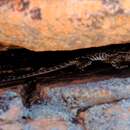en
names in breadcrumbs


Houston's dragon is an endemic vertebrate to the Tirari-Sturt Stony Desert, an ecoregion of southern Australia that occupies a land area of approximately 145,500 square miles. During the austral summer, maximum temperatures can attain values of 50 degrees Celsius. Human habiation of the Tirari-Sturt Stony Desert is minimal.
In addition to large extents of stony plain and sands, the Tirari-Sturt Stony Desert exhibits areas of chenopod vegetation, mallee and acacia (mulga) wooded scrubland. The region manifests a gamut of wildlife that has successfully adapted to the hot and arid conditions, notably including wedge-tailed eagle (Aquila audax), the Near Threatened yellow-footed rock-wallaby (Petrogale xanthopus) and western gray kangaroo (Macropus fuliginosus) within the Flinders Ranges.
Special status birds of this ecoregion include the Endangered plains wanderer (Pedionomus torquatus), Near Threatened Alexandra's parrot (Polytelis alexandrae), the Near Threatened Australian bustard (Ardeotis australis), the Near Threatened black-tailed godwit (Limosa limosa), the Near Threatened buff-breasted sandpiper (Tryngites subrificollis), the Near Threatened bush thick-knee (Burhinus grallarius), the Near Threatened chestnut-breasted whiteface (Aphelocephala pectoralis), the Near Threatened desert firetail (Stagonopleura guttata), the Near Threatened flame robin (Petroica phoenicia), the Near Threatened letter winged kite (Elanus scriptus), the Near Threatened grey falcon (Falco hypoleucos), the Vulnerable fairy tern (Sterna nereis), the Vulnerable great knot (Calidris tenuirostris), the Vulnerable malleefowl (Leipoa ocellata) and the Vulnerable painted honeyeater (Grantiella picta).
Ctenophorus vadnappa, commonly known as the red-barred dragon[2][4] or red-barred crevice-dragon[3][1] is a species of agamid lizard occurring in rocky outcrops and ranges in semi-arid to arid South Australia, from the northern Flinders Ranges to hills north of Lake Torrens.[4]
Ctenophorus vadnappa, commonly known as the red-barred dragon or red-barred crevice-dragon is a species of agamid lizard occurring in rocky outcrops and ranges in semi-arid to arid South Australia, from the northern Flinders Ranges to hills north of Lake Torrens.